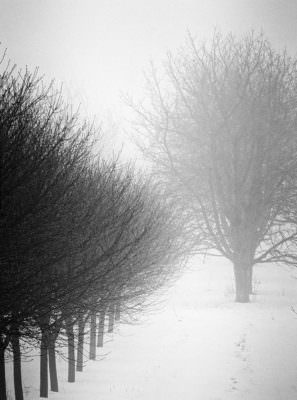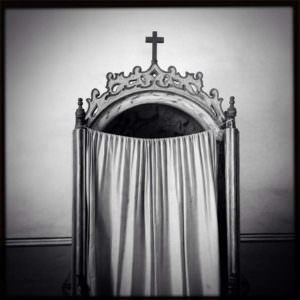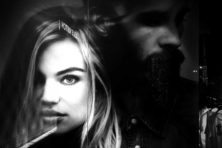Questions & Artists: Photographer Arlene Stanger
- Share
- Tweet
- Pin
- Share

It was the magic of the dark room that drew Arlene Stanger to photography in 1972 and it is the magic of iPhone photo apps that continues to inspire the award-winning Door County photographer.
After nearly four decades of capturing landscapes, flowers and industrial buildings as a hobby photographer, Stanger and her husband Steven moved to Door County where her passion for photography has flourished since 2009.
Her warm and evocative portfolio of landscapes, urbanscapes and nature photography has earned her placement in several local exhibitions – including the Miller Art Museum and the gallery at Door County Medical Center – and countless local, regional, national and international awards, from the Peninsula Pulse’s Hal Prize to the Julia Margaret Cameron Award for Women Photographers in Berlin, Germany. Her photography can be viewed at stangerimage.com.

“Foggy Orchard” by Arlene Stanger.
Peninsula Pulse (PP): How did you get into photography?
Arlene Stanger (AS): My husband I got into it when we were in California. He was studying Russian at the Defense Language Institute in Monterey with the Army and on base they had a dark room. That was my first introduction to photography other than just snapshots. I could use the dark room free of charge and basically that’s how I started. We went to Germany after that and I used the dark room on the Berlin base a couple of times then when we moved back to the states in Illinois we had a dark room in our basement.
PP: How do you define your style?
AS: I guess you could call my style “pictorialist.” Typically a pictorial photograph has a soft focus and dramatic lighting and shading that conveys an atmosphere of suggestion and mystery. It is reminiscent of the paintings of the late 19th century before Impressionism. Pictorialism emphasizes photography’s ability to create visual beauty rather than simply record facts.
PP: What are you most interested in conveying through your photos?
AS: My aim in photography is to create images that will elicit an emotional response from the viewer and invite them to take a deeper look and come up with their own interpretation of the subject matter. I am continually searching for interesting shapes, textures and light qualities that will create images that will do this.
PP: Who are your biggest influences?
AS: Some of the photographers I admire are Julia Margaret Cameron and Edward Steichen, both of whom were pictorialists, and Imogen Cunningham, who started out as one. I also enjoy and am inspired by the photography of Minor White and Paul Caponigro. Closer to home, I admire Suzanne Rose who has inspired me and given me encouragement in my photographic journey.

“Atonement” by Arlene Stanger.
PP: You have won numerous honors and been juried into several exhibits. What do you consider your biggest honor?
AS: Last year my photo was a winner in the landscape category of the Julia Margaret Cameron Award for Women Photographers exhibit. Winners from that exhibit, along with four or five other photographic exhibits, were all brought together and they were exhibited in Berlin, Germany. Steve and I used to live in Berlin, Germany so we decided to take a trip over there and we did go to the opening for that so that was very exciting.
PP: What is the most important piece of photography equipment you own?
AS: This is going to surprise people – it’s my iPhone. I started out with a film camera then digital and then I took a class at the Art School with a Holga camera, which is a cheap, plastic camera that only cost $40. It has a plastic lens and it uses film so after I took that class at the art school I got into that and I used that most of the time. When we got our smartphones I took a class with Suzanne Rose and after that class, that’s basically what I’ve been using. It’s cliché, they say the best camera is the one that you have with you, but it’s true because I have that all the time.
PP: Any advice for budding photographers?
AS: Just get out there and start shooting, and have your camera with you all the time…you never know when you’re going to run across something that’s just going to be fantastic.

